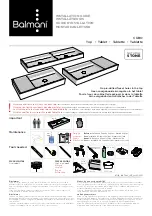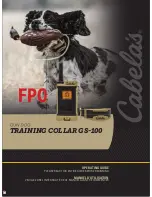
G.) If the indicator light did not come on, you may assume there is a break in this portion of the
boundary. As a result of there being a small chance of having more than one break in your system, you
should repeat Steps E and F for the other half of the boundary. Unplug the AC adapter.
H.) You can narrow down where the break is by repeating Steps C-G. Remember when you cut another
section of wire, you must splice the first cut you made and seal it with silicone. The number of times
you repeat these steps depends on how much wire you are willing to replace.
I.) Replace the damaged wire with new wire. Note: Remember to use only Pet Containment System
wire. Plug in the AC adapter.
J.) Check the Loop Indicator Light. If the light is on, test the system with the receiver collar.
Radio Systems Corporation shall not be liable for any property damage,
economic loss, or any consequential damages sustained as a result of
an animal crossing the boundary.
TRAINING
Orientation
During the training process it is VERY IMPORTANT that you DO NOT let your pet run free
with
or without
wearing the receiver. If you do, it may confuse him. To facilitate the conditioning process,
keep him on a leash during the fi rst week. But DO NOT walk your pet over the boundary line with the
leash. This may confuse him in the beginning. Eventually, you will be able to take him with you over the
boundary with the leash. But for now, if he needs to leave the yard, place him in the car, or carry him well
over to the other side of the signal fi eld. Remove his collar before taking him from the yard by either of
these options, or he will get corrected as he leaves.
To allow your pet to become accustomed to the contact points on his neck, remove the receiver after each
training session during the fi rst week. After that, remove the receiver each night. Eventually he will be able
to wear the receiver all the time, but it will take time for his skin to develop a tolerance to the contact points.
The training fl ags are there for two reasons. First, to give your pet a temporary visual boundary and
secondly to help you with the training. The fl ags are installed where the warning beep starts. All of the fl ags
will remain in the yard for about two weeks. Then they will be slowly removed until they are all out.
Remember, training should be fun, fair, fi rm, and consistent. Make each session short and upbeat. Many
dogs have extremely short attention spans, so don’t get discouraged. He will eventually learn.
Phase-1 Day 1______ Day 2______ Day 3______
Place a leash on your pet using a non-metallic flat or slip collar in addition to the receiver collar. Do not
place the leash on the receiver collar, and ensure that the leash collar is attached higher on your dog’s neck
than the receiver collar – otherwise, the leash may pull on the contact points and injure your dog’s neck.
Prior to placing the receiver collar on your pet, turn the transmitter off so your pet will not experience a
correction. Your pet needs to fi rst be taught how to respond to the fl ags. Walk your pet within the safe area
of the yard and calmly praise and talk to him. Now, proceed toward the training fl ags. Before your pet’s
head reaches the fl ags, give your pet a quick horizontal or downward “jerk and release” correction on the
leash. Pull your pet back about 15 feet into the safe area and praise him. (
“Good Rover, you are so smart ...
Let’s go.”
) The “jerk and release” is the only negative reinforcement your pet needs.
There is no verbal
correction needed.
You should tailor the corrections to your pet’s personality, temperament, size and
breed.
Each training session should only last about 10 to 15 minutes.
Enter the boundary at various places
and focus on areas that the family typically would leave the yard (i.e., drives ways, sidewalks, etc....). Soon
you should see your pet begin to avoid the fl ags. This shows he is learning. Make sure you play with your
pet in the safe area of the yard to show him that time spent in the yard is a pleasant experience. This will
prevent your pet from becoming timid or tentative about going outside.
Remember, keep him on a leash, even to go out to take his biological breaks.
Note
:
Some dogs are able to assimilate this information quicker than others. Before proceeding to
Phase
2
, be sure your dog is happy to run and play in the yard, generally avoiding the fl ags. If not, spend an extra
day or two on
Phase 1
.
Phase-2 Day 4______ Day 5______ Day 6______
During
Phase 2
your pet is still on the leash. Turn the transmitter on. Your pet can now experience the
correction of the system. Walk your pet within the safe area of the yard and calmly praise and talk to
him. Allow your pet to proceed toward the training fl ags. When your pet enters the signal fi eld, he will
9
Summary of Contents for pig19-10761
Page 71: ......










































